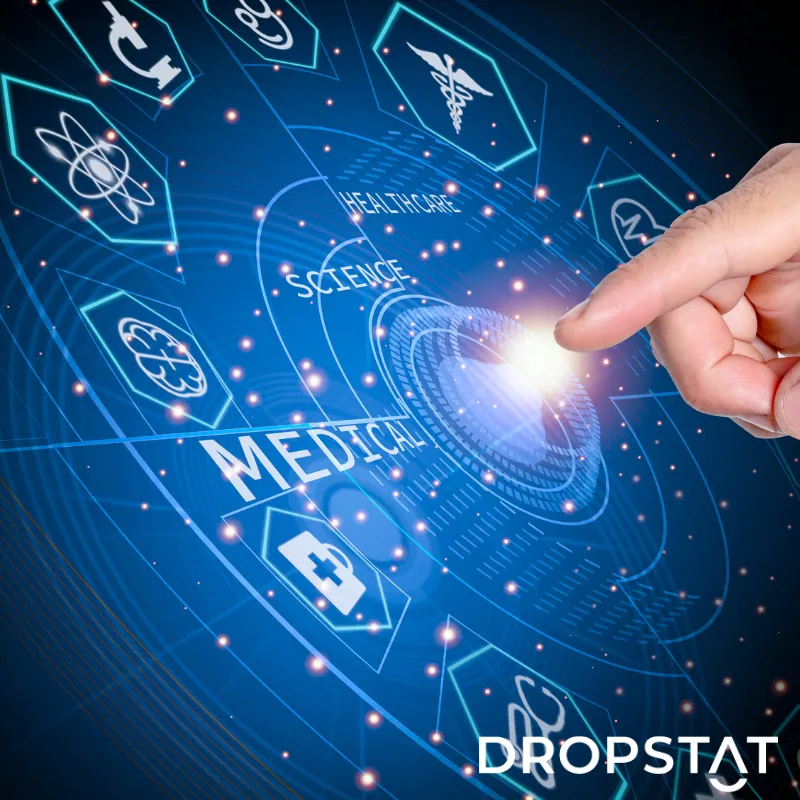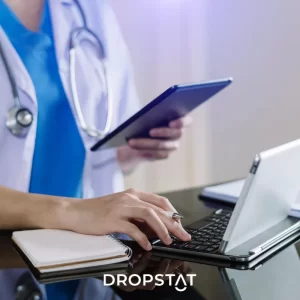What is technology in nursing?
Technology in nursing uses various tools and technological innovations, improving patient outcomes, enhancing communication among healthcare professionals, and increasing efficiency in healthcare facilities. Nursing technology aims to empower nurses with the tools and resources they need to deliver optimum patient care more efficiently while improving healthcare outcomes and reducing healthcare costs.
The advantages of technology in nursing
- Improved patient outcomes
One of the primary benefits of technology in nursing is its potential to improve patient outcomes. With the help of advanced technology, nurses can better monitor and manage patient conditions, resulting in faster recovery times and reduced hospital stays. For example, electronic health records (EHRs) allow nurses to access patient electronic medical records almost in real time, giving nurses instant access to accurate and up-to-date information about a patient’s medical history, medication list, or allergies. Technology can help nurses make informed decisions and avoid medication errors in nursing, ultimately leading to better patient outcomes.
- Increased efficiency
Another advantage of nursing technology is its ability to increase efficiency. With the help of automation and digital tools, nurses can spend less time on administrative tasks and more time on patient care. For example, electronic medication administration records (eMARs) enable nurses to record medication administration electronically, eliminating the need for paper-based records.
- Enhanced communication
Technology in nursing has also revolutionized communication among healthcare professionals, leading to improved collaboration and better patient outcomes. For instance, telehealth technologies have made it easier for nurses to communicate with patients and doctors remotely, providing timely care and reducing the need for in-person visits. Similarly, mobile communication devices such as smartphones and tablets enable nurses to communicate with colleagues and access patient information on the go, improving care coordination and reducing delays.
- Enhanced patient safety
Technology in nursing can help reduce medication errors, prevent adverse events, and improve patient safety through features such as electronic medication administration records (eMAR), barcode scanning for medication verification, and electronic health records (EHR) that provide real-time access to critical patient information.
- Geographical flexibility
Healthcare facilities that use better nursing technology enable nurses to provide care remotely through telehealth and remote monitoring tools. Telehealth allows for remote consultations, monitoring of vital signs, and virtual patient assessments, making it easier for nurses to reach patients, increasing patient convenience, and potentially reducing healthcare costs.
- Improved workflow and documentation
Technology streamlines nursing workflow by automating routine tasks, such as documentation, scheduling, and billing, which can save time and reduce the administrative burden. Electronic documentation also promotes the accuracy and completeness of patient records, improving continuity of care and communication among healthcare team members.
- Access to evidence-based practice
Evidence-based practice promotes best practices, standardization of care, and continuous learning among nursing professionals. Technology gives nurses easy access to evidence-based nursing practice, guidelines, and educational resources, enabling them to make informed and evidence-based decisions in patient care.
- Increased patient engagement
Technology empowers patients to take an active role in their healthcare by providing access to personal health records, patient portals, and health apps. Health apps allow and encourage patients to monitor their health, communicate with their healthcare providers, and participate in shared decision-making, which promotes patient engagement, patient-centered care, and better health outcomes.
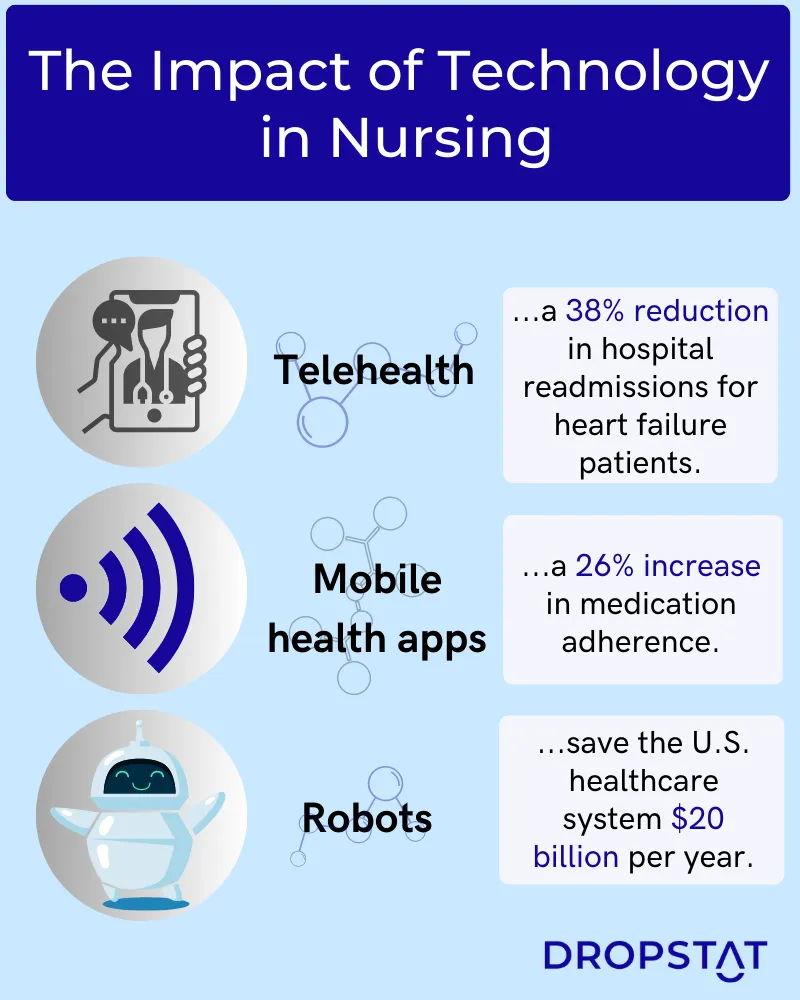
The disadvantages of technology in nursing – and how to overcome them
Despite its benefits, technology in nursing also has its challenges.
- Increased reliance on technology
One of the most significant drawbacks of technology in nursing is its potential to increase reliance on technology, leading to a loss of critical thinking skills and decreased ability to react to unexpected situations. For example, relying too heavily on electronic monitoring systems may prevent nurses from noticing important signs of patient deterioration or miss subtle changes in a patient’s condition. Possible solutions include promoting technology as a tool that complements critical thinking skills, not replaces them. By offering ongoing training in prior and newer skills, nurses can balance leveraging technology and maintaining their critical thinking skills to deliver safe and effective patient care.
- Lack of familiarity or comfort with technology
Some nurses may feel intimidated or need more confidence when using new technology. Managers can overcome this by providing adequate training and education for registered nurses on how to use the technology, including hands-on practice and support from IT personnel. Offering ongoing support and opportunities for nurses to ask questions and seek clarification can also boost their confidence in using the technology effectively.
- Resistance to change
Nurses, like any other professionals, may experience resistance to change when adopting new technology. Facility managers can overcome this through effective change management strategies, such as involving nurses in the decision-making process, providing clear communication about the benefits of the technology, addressing concerns, and providing support during the transition period. Creating a positive and supportive environment that encourages open communication and expectations for positive feedback can also help overcome resistance to change.
- Integration with existing systems
Integrating new technology with existing systems, such as electronic health records or other systems for information technology in nursing, can pose challenges. Involving IT personnel and nurse managers from different departments in the planning and implementation processes can help identify and address potential integration issues early on.
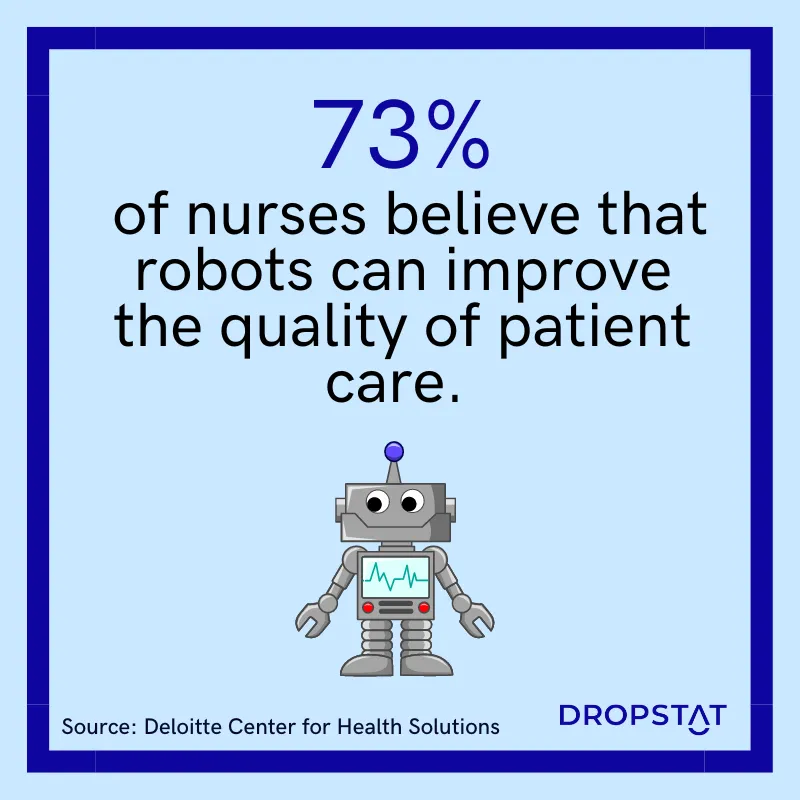
How could technology change the nursing workload?
Technology in nursing can both reduce and increase the nursing workload. Part of the effect of technology depends on the nurses themselves and how they adapt to the technologically advanced future. However, the significant impacts of adopting new technologies in healthcare facilities depend on how healthcare managers implement the changes.
How advancements in nursing technology may reduce nurses’ workload
- Increased efficiency: Using technology can streamline routine nursing tasks, such as charting. Using electronic health records (EHRs), nurses can quickly and easily document patient assessments, interventions, and outcomes using templates, drop-down menus, and other tools. EHRs also allow for easy retrieval of patient information, eliminating the need for manual searching through paper records, saving time and improving efficiency, and freeing up time for other patient care activities.
- Improved accuracy: Technology can help to reduce errors and increase accuracy in nursing tasks, such as medication administration and medication reconciliation, minimizing the risk of adverse events.
- Better communication: Technology can improve communication among healthcare professionals, enabling nurses to collaborate more effectively with other healthcare team members and reducing the need for time-consuming phone calls and in-person meetings.
- Remote patient monitoring: Technology allows nurses to monitor patients remotely. Remote patient monitoring reduces the need for actual bedside visits and allows nurses to provide care to more patients simultaneously.
How new technology in nursing may increase nurses’ workload
- Ramp-up time: Adopting new technologies can initially increase the workload for nurses until they learn how to use the new systems and adapt to the new workflows.
- Technical issues: Technical issues are common in advanced technology and can cause downtime and delays in workflow. Technical workarounds increase the time and effort required to complete routine tasks.
- Increased documentation: Electronic mental health records often require more detailed documentation than paper records, which increases the overall time needed for documentation.
- Security risks: The use of nursing technology can increase security risks. Nurses must comply with cybersecurity guidelines, reporting requirements, and organization-specific policies to protect information from hacking and cyberattacks. Some examples of workload increases are remembering passwords, avoiding and addressing data breaches, and periodic training for security in technology.
Overall, the impact of technology on nursing workload depends on how healthcare facilities implement and use it. Technology can be a strategic tool that reduces the nursing workload, allowing nurses to focus on more complex tasks and provide better patient care. However, if healthcare facilities do not implement technology properly, it can create more work for nurses. Paradoxically, the tool intended to help reduce workload can lead to increased burnout, decreased job satisfaction, and decreased quality of patient care.
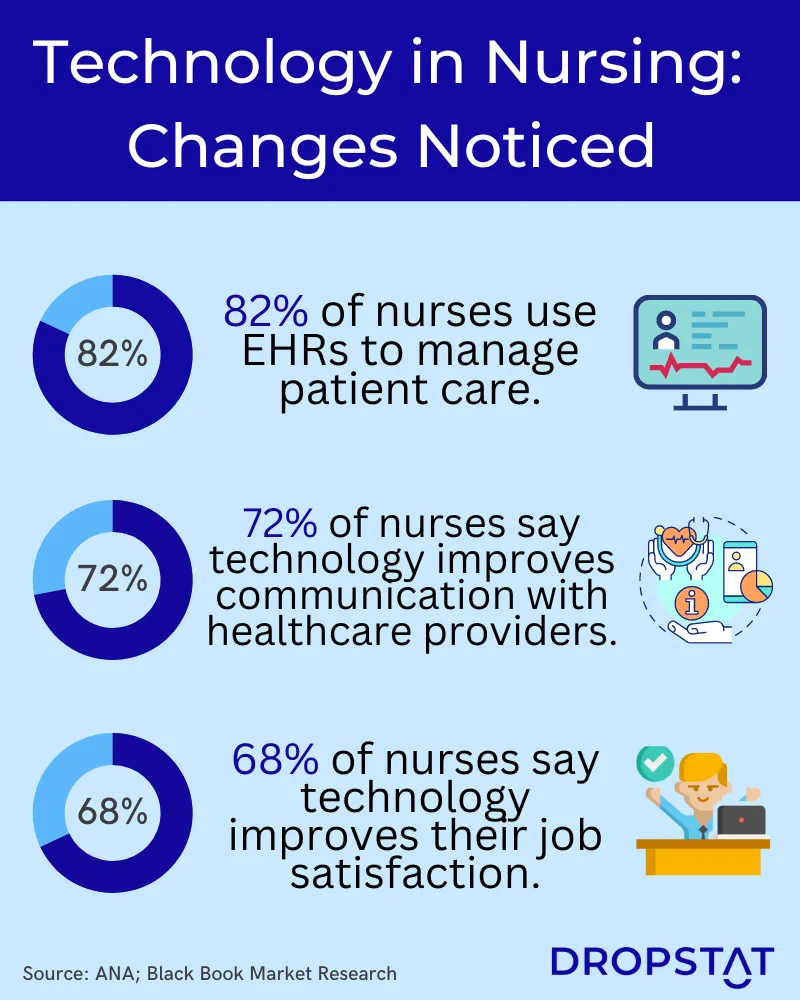
How technology in nursing could change nursing in the future
Technology is rapidly transforming the healthcare industry and nursing. There are many ways in which technology will shape nursing practices, roles, and workflows in the future.
Enhanced patient monitoring
The use of remote monitoring technologies, such as wearables and sensors on smart beds, is expected to increase, enabling nurses to monitor patients remotely and collect data on their health status. Monitoring technologies will enable earlier detection of health issues and more personalized patient care.
Data technologies
These include big data analytics, artificial intelligence, and machine learning which will become more prevalent in healthcare. Big data provides the data, healthcare data analytics provides the examination and interpretation of data, and AI/machine learning provides the ability for systems to learn and make decisions based on that data. Nurses will need to use these tools to gain insights, make healthcare predictions, and support their clinical decision-making.
Telehealth
Telehealth technologies, such as videoconferencing and remote consultation tools, are expected to become more widespread, enabling nurses to provide care to patients remotely. Telehealth will improve access to health care even for patients in remote areas and reduce the need for nurses to travel to patients.
Robotics
The use of robotics in healthcare is expected to increase, with robots working in tasks such as medication delivery, patient lifting, and cleaning to reduce the physical strain on nurses and injuries and free up time for more complex patient care tasks.
Advanced imaging
Advanced imaging technologies, such as 3D printing and virtual reality, are expected to become more prevalent in healthcare, enabling nurses to visualize better and understand complex medical issues.
Augmented reality
Augmented reality (AR) technologies, such as smart glasses, are expected to become more prevalent in healthcare, enabling nurses to access patient information and medical records hands-free. AR will improve workflow efficiency and reduce the risk of medical errors.
The future of nursing will be increasingly technology-driven. Nurses will need to rely on a wide range of tools and technologies as part of nursing to provide optimum patient care. Technology in nursing can bring many benefits, but nurses need to receive proper training and technical support to ensure that they can effectively use these technologies to the best advantage of the patients and the nurses themselves.
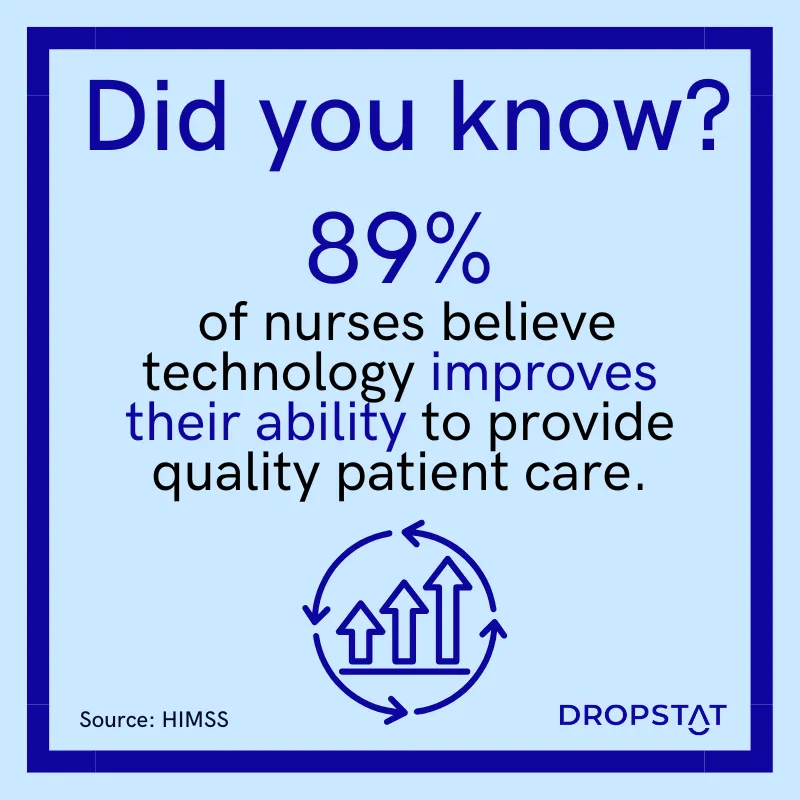
How Dropstat uses advanced AI technology in nursing
Dropstat is an AI-driven staff scheduling app that uses advanced technology to help nurse managers fill shifts effectively and cost-efficiently. Dropstat helps streamline communication between nurse managers, schedulers, and nurses. From the palm of their hand, staff schedulers can see at a glance which shifts are open and send out shift requests to all relevant nurses. Likewise, nurses can pick up or request shifts with the click of a button.
Dropstat mitigates the potential challenges of nurses adapting to new technology by providing facilities with hyper-care. Dropstat’s committed project management team offers two months of specialized support for your facility until your nurses are all onboard.
Dropstat’s advanced technology ensures the smooth operation of the healthcare facility while ensuring that every shift has all staff on board and is HPPD compliant.
Schedule a demo now to harness Dropstat’s technological advances to help your healthcare facility become a safer place for nurses and patients.
FAQs
Are nurses on board with the advancing technology in healthcare?
Nurses generally recognize the benefits of advancing technology in healthcare. However, there may be challenges related to adopting the technology, training, workflow integration, and maintaining thinking skills. When facilities address adaptation issues that crop up effectively, studies show that nurses generally respond positively to the use of technology in healthcare settings. A Black Book market research survey found that 68% of nurses believe that technology improves their job satisfaction. That is encouraging, as is the fact that 91% of nurses surveyed were willing to try using digital learning tools.
How many older nurses reject new technology?
Some nurses fear new technology will push them out of their jobs. Managers could reduce technophobia in nurses if they assure nurses that improving technology in nursing is intended to be a solution to the high patient-to-nurse ratios and not in order to reduce the number of human nurses working in healthcare facilities.
Technostressors refer to the negative psychological and physiological impacts of using technology. Studies show that healthcare technology was the cause of stress in 73% of people who work in healthcare, with 40% of people experiencing moderate/high-stress levels. Age may be a factor, but the study clearly showed that technostress differed significantly between one medical setting and another.
How well do younger nurses adapt to new technology in the nursing profession?
Generation Z nurses feel digitally equipped and ready to use technological tools in their jobs. Younger nurses are better equipped to be technologically skilled. People may be willing to work as nurses as it is less hands-on and more technology oriented. Increasing the number of new technically savvy nurses may solve the shortfall of traditional nurses predicted by the WHO by 2030


